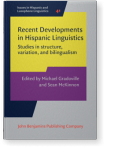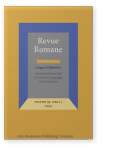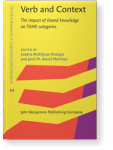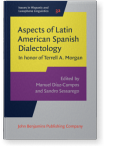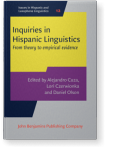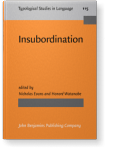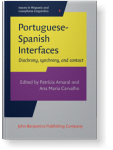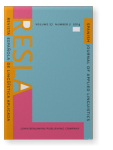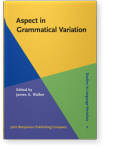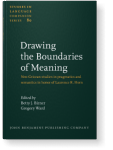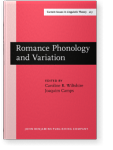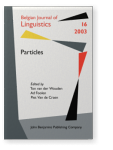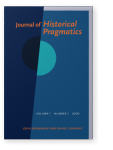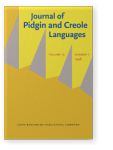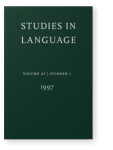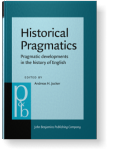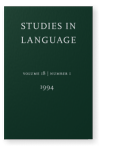Scott A. Schwenter
List of John Benjamins publications for which Scott A. Schwenter plays a role.
Book series
Journal
ISSN 0035-3906 | E-ISSN 1600-0811
2023 The role of context in imperative form choice Verb and Context: The impact of shared knowledge on TAME categories, Rodríguez Rosique, Susana and Jordi M. Antolí Martínez (eds.), pp. 327–350 | Chapter
When languages have more than one dedicated imperative, the distinct forms often correspond to different person/number combinations. But what happens when there is variation between two forms for the same person/number combination, e.g. 2nd person singular? This chapter analyzes the competing… read more
2021 Chapter 3. Variable constraints on se lo(s) in Mexican Spanish Aspects of Latin American Spanish Dialectology: In honor of Terrell A. Morgan, Díaz-Campos, Manuel and Sandro Sessarego (eds.), pp. 47–68 | Chapter
We examine the alternation between normative se lo/la and se los/las to express a plural indirect object and singular direct object. Using corpus data from Mexico City and Monterrey, we find that significant predictors of the more frequent variant, se los, are number of the verb, referential… read more
2020 Chapter 1. Cross-dialectal productivity of the Spanish subjunctive in nominal clause complements Variation and Evolution: Aspects of language contact and contrast across the Spanish-speaking world, Sessarego, Sandro, Juan J. Colomina-Almiñana and Adrián Rodríguez-Riccelli (eds.), pp. 11–32 | Chapter
We performed a large-scale corpus study of the subjunctive across Argentine, Mexican, and Peninsular Spanish, in order to determine possible differences in productivity across dialects. Our data (N = 6,822) from the web/dialects section of Davies’ (2016–)
Corpus del Español were collected… read more
2018 Chapter 4. Variable negative concord in Brazilian Portuguese: Acceptability and frequency Contemporary Trends in Hispanic and Lusophone Linguistics: Selected papers from the Hispanic Linguistic Symposium 2015, MacDonald, Jonathan E. (ed.), pp. 71–94 | Chapter
We provide empirical evidence that colloquial Brazilian Portuguese (BP) is a variable negative concord language, which allows negative indefinites (NIs) to occur in postverbal position without a preverbal negative licensor, as in Vi nada ontem ‘I saw nothing yesterday.’ The results of an online… read more
2017 Chapter 5. Null objects with and without bilingualism in the Portuguese- and Spanish-speaking world Multidisciplinary Approaches to Bilingualism in the Hispanic and Lusophone World, Bellamy, Kate, Michael W. Child, Paz González, Antje Muntendam and M. Carmen Parafita Couto (eds.), pp. 95–121 | Chapter
Null anaphoric direct objects (ADOs) have received increasing scholarly attention over the last 10–15 years in Spanish and Portuguese (e.g.Choi 2000;Gómez Seibane 2011,2013; Reig 2008,2009;Schwenter & Silva 2003;Schwenter 2014). We synthesize this research and indicate some points of connection and… read more
2016 Vosotros, ustedes, and the myth of the symmetrical Castilian pronoun system Inquiries in Hispanic Linguistics: From theory to empirical evidence, Cuza, Alejandro, Lori Czerwionka and Daniel Olson (eds.), pp. 263–280 | Article
In studies of T/V address systems, research typically ignores plural forms in favor of their singular counterparts. We show that there is widespread asymmetry between singular and plural T/V forms in Castilian Spanish, and that the historically T plural vosotros often serves as the plural of both… read more
2016 Chapter 4. Independent si-clauses in Spanish: Functions and consequences for insubordination Insubordination, Evans, Nicholas and Honoré Watanabe (eds.), pp. 89–112 | Article
This chapter focuses on a particular use of subordinate-marked si ‘if’ clauses in Spanish as independent declaratives, which typically form the second part of a dialogic interaction with adversative speech act function. I provide both syntactic and prosodic evidence for the status of these… read more
2014 Two kinds of differential object marking in Portuguese and Spanish Portuguese-Spanish Interfaces: Diachrony, synchrony, and contact, Amaral, Patrícia and Ana Maria Carvalho (eds.), pp. 237–260 | Article
Portuguese is typically not considered a differential object marking (DOM) language, while Spanish, with its accusative a, is one of the most well-known DOM languages. This chapter uses quantitative multivariate analysis to argue that Portuguese – both Brazilian (BP) and European (EP) – displays a… read more
2014 Competing constraints on the variable placement of direct object clitics in Mexico City Spanish Revista Española de Lingüística Aplicada/Spanish Journal of Applied Linguistics 27:2, pp. 514–536 | Article
We utilize variationist methodology to explore the conventionalization and pragmatics of 3rd person direct object clitic placement in Spanish periphrastic constructions. Analysis of 652 tokens extracted from three Mexico City speech corpora indicates that while proclitic position is the majority… read more
2010 Chapter 2. Grammaticalization paths as variable contexts in weak complementarity in Spanish Aspect in Grammatical Variation, Walker, James A. (ed.), pp. 13–26 | Article
2006 Fine-tuning Jespersen’s Cycle Drawing the Boundaries of Meaning: Neo-Gricean studies in pragmatics and semantics in honor of Laurence R. Horn, Birner, Betty J. and Gregory Ward (eds.), pp. 327–344 | Article
2005 Polar meaning and “expletive” negation in approximative adverbs: Spanish por poco (no) The Evolution of Pragmatic Markers, Mosegaard Hansen, Maj-Britt and Corinne Rossari (eds.), pp. 262–282 | Article
In this paper we provide a synchronic and diachronic analysis of an instance of so-called “expletive” negation in the Spanish approximative adverb por poco. Synchronically, we show that this adverb, when combined with the sentence negator no, is ambiguous between ~p (“expletive”) and ~~p… read more
2003
A scalar propositional negative polarity item in Spanish
A Romance Perspective on Language Knowledge and Use: Selected papers from the 31st Linguistic Symposium on Romance Languages (LSRL), Chicago, 19–22 April 2001, Núñez-Cedeño, Rafael, Luis López and Richard Cameron (eds.), pp. 119–132 | Article2002 Discourse context and polysemy: Spanish casi Romance Phonology and Variation: Selected papers from the 30th Linguistic Symposium on Romance Languages, Gainesville, Florida, February 2000, Wiltshire, Caroline R. and Joaquim Camps (eds.), pp. 161–175 | Article
2002 Additive particles and scalar endpoint marking Particles, Wouden, Ton van der, Ad Foolen and Piet Van de Craen (eds.), pp. 119–134 | Article
2000 Invoking scalarity: The development of in fact Journal of Historical Pragmatics 1:1, pp. 7–25 | Article
The discourse contexts are analyzed in which clause-internal in fact developed pragmaticalized meanings and came to invoke scalarity in two domains: epistemic sentence adverb (IPAdv), and additive discourse marker (DM). In both these uses, in fact tightens word to world fit (Powell 1992): the world… read more
1997 Review of Labov (1994): Principles of linguistic change, Volume 1: Internal factors Studies in Language 21:1, pp. 228–236 | Review
1995 The Semantic and Pragmatic Development of Substitutive Complex Prepositions in English Historical Pragmatics: Pragmatic developments in the history of English, Jucker, Andreas H. (ed.), pp. 243–274 | Article
1994 The Grammaticalization of an Anterior IN Progress: Evidence from a Peninsular Spanish Dialect Studies in Language 18:1, pp. 71–111 | Article
This paper investigates the current grammaticalization of the Spanish Present Perfect, an anterior grammaticalizing to perfective, in the dialect of Alicante, Spain. The evidence offered provides insight into this grammaticalization process, and into the development of hodiernal tenses (cf. Dahl… read more
